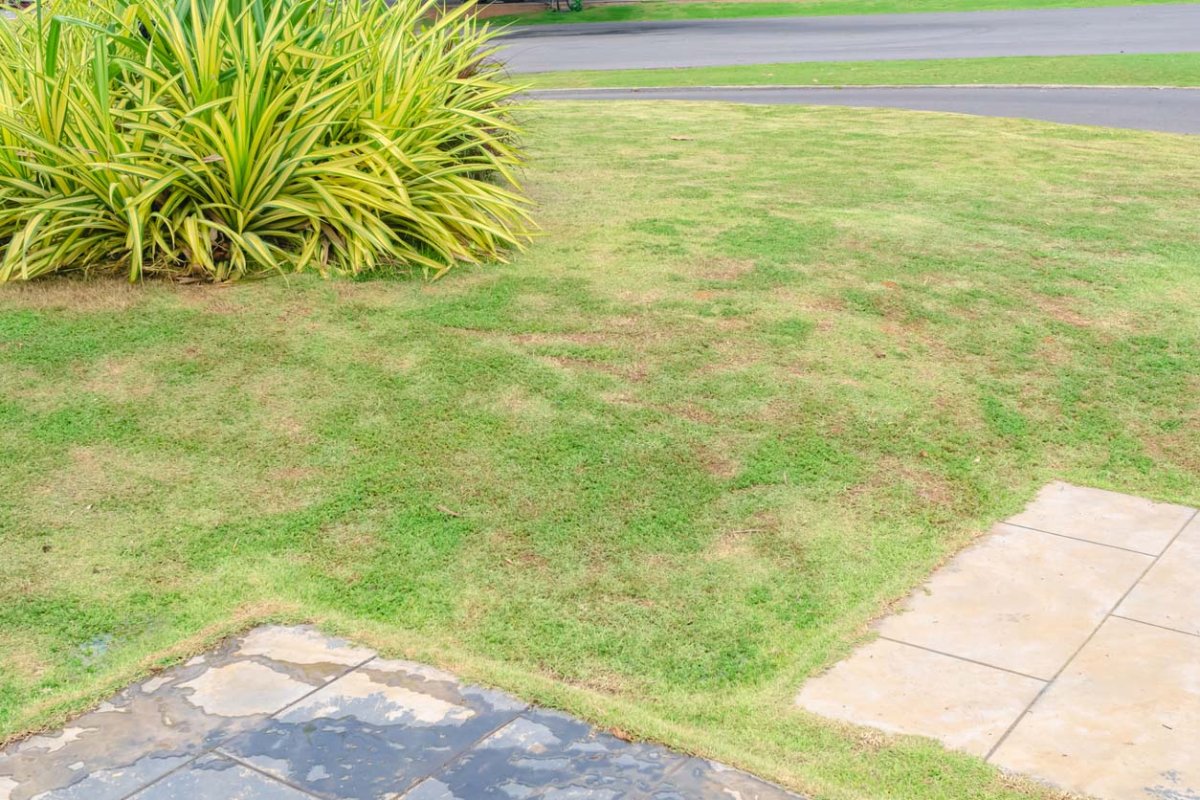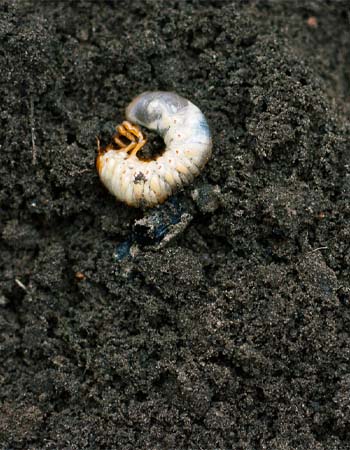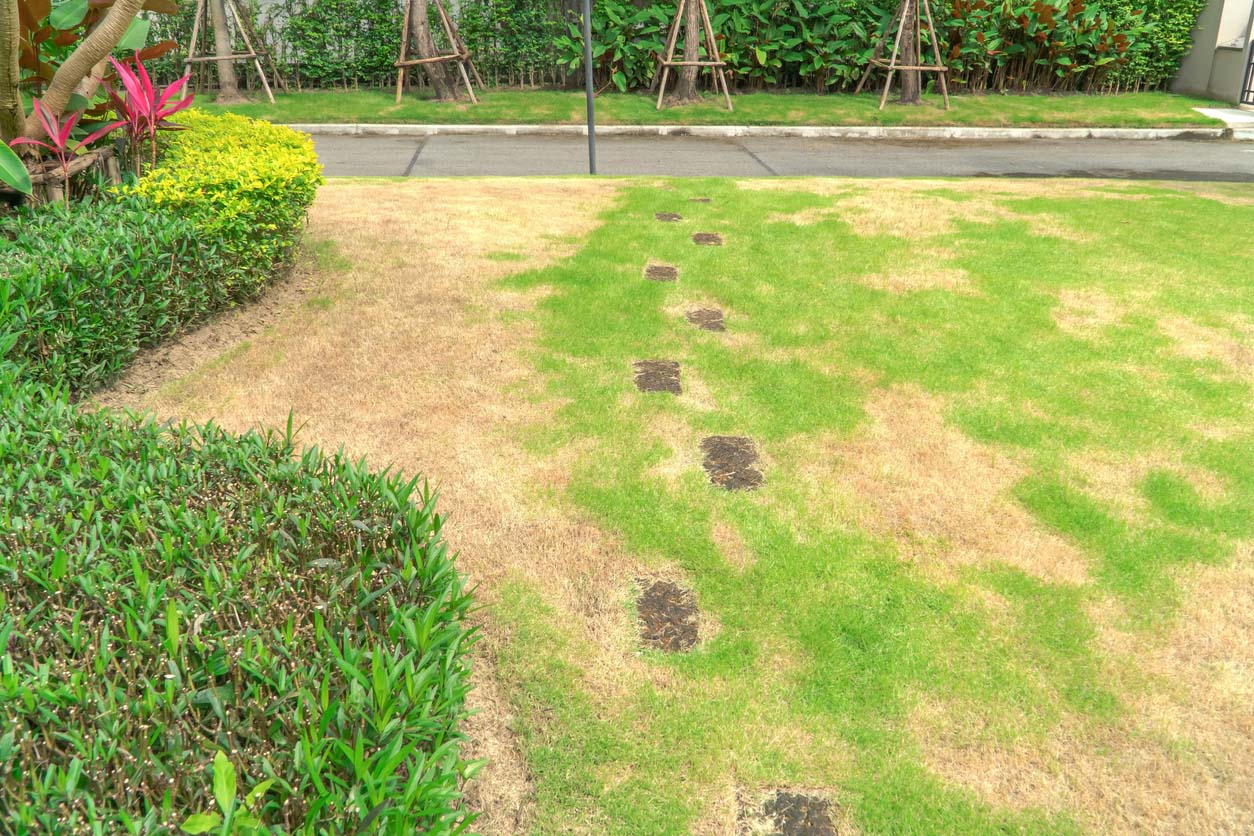

We may earn revenue from the products available on this page and participate in affiliate programs. Learn More ›
Grub damage versus fungus problems can look similar, but there are a few ways to determine if the unsightly dead patches of grass are caused by the presence of grubs or fungal disease.
Grubs are the larvae of beetles and have a white, worm-like appearance. The grubs feed on the roots of turfgrass and can live in the larval stage for between 1 and 3 years. Grubs live in soil that doesn’t have nematodes, which are worms that survive from eating grubs. Using artificial fertilizers and overfertilizing a lawn can kill off the nematodes, which allow grubs free rein of the lawn.
When once-healthy grass has brown spots and areas of dead grass, those are signs of grub infestations or some type of lawn disease. Diagnosing the problem is important to begin grub control treatment with one of the best grub killers or administer one of the best lawn fungicides for turf diseases.

1. Grub damage often looks like dark or brown spots of grass, while fungal damage may look like white, gray, or black powder on the grass with discolored roots and stems.

The symptoms of grub damage and fungal infections can be similar, but there are a few important characteristics of each to determine the problem. Signs of grub damage include brown grass, bare spots in the lawn, or crescent-shaped or circular patterns of brown patches. Dead spots caused by lawn grub damage are typically seen in sunny areas of the lawn where the soil is warm. White grubs like to eat the roots of the grass, which will create a soft and spongy texture to the lawn. Since many animals, such as raccoons, birds, and skunks, like to snack on grubs, an increase of these animals in the yard area can be another sign of a grub infestation.
The signs of fungal damage on a lawn appear as white, gray, or black powdery patches of grass. Another sign is orange, red, purple, black, or gray spots on the stem and roots of the grass.
Fungal spores can damage a lawn when the conditions are right. These can include overwatering, compact soil, poor soil drainage, overuse of fertilizer, drought conditions, and improper mowing.
2. Grub-damaged grass is easy to lift up from the ground, whereas fungus-infected grass resists being lifted.
When lawn grubs eat away at grass roots, the grass blades will turn brown, die, and leave irregular patches across the lawn. As a result, the grass will lift easily from the ground when pulled. To test to see if you have grub damage, pull at a patch of brown grass and see if it comes out of the ground with no effort. A fungal infestation doesn’t attack the root system, so the grass will provide some resistance when it’s tugged out of the soil.
3. A grass patch with a fungal infection may look wet and slimy.
Grass that has a diagnosis of turfgrass disease may appear wet or slimy. Since fungi flourish in damp and moist areas, the infected grass may take on a greasy look. These wet areas may also smell like mold or rotting organic matter.
4. Grub damage often occurs in warm, sunny areas of the yard, and there may be increased animal traffic. The ground will also be soft and springy.
Lawn grubs like to be in areas of the lawn that are exposed to the most sunlight. The warm temperatures will heat up the soil and spur the grubs to eat and grow. The grub activity will also attract animals such as birds, skunks, and raccoons to the areas of the lawn where they can dig and scratch at the dead grass to snack on the grubs. Grub-damaged areas of the lawn will feel soft and spongy when they’re walked on, since the area will stay damp as a result of the absent root system. Grubs can infest lawns for a variety of reasons, such as when the ground is too wet from overwatering; when a lawn has been aerated too much, which creates convenient holes for beetles to lay their eggs; and when the grass is cut too short, which results in a shortened and weakened root system.

5. Fungal infections can be caused by drought or overwatering, as well as poor soil drainage and nutrition.
Fungal problems can happen for a variety of reasons, including overwatering the grass, using the wrong type of fertilizer, overfertilizing, having compacted soil, or mowing improperly. The presence of high levels of humidity, unusually hot temperatures, or even drought conditions can also contribute to fungal problems. A dollar spot, or small tan-colored crusted patches the size of a silver dollar, is one of the early signs of a fungal infection. The identification of summer patch disease, dollar spot, snow mold, red thread, brown patch symptoms, and other fungal diseases will require the expertise of a lawn care professional. Finding the root of a lawn problem can help homeowners treat the issue as quickly as possible.
6. Grubs and their eggs thrive in wet soil and moist grass.
Since beetles lay their eggs in the rainy season of early summer, the larvae will live just below the ground. They thrive in wet soil and moist grass and prefer areas that are warmed by the sun. They won’t typically reside in areas of the lawn that are perpetually shaded.
7. A professional or DIY lawn care program can treat and prevent both grubs and fungus.
Some homeowners prefer to DIY their lawn care program to deal with grub or fungus issues, but for severe infections, it’s best to consult a professional. Some DIY solutions involve adhering to a proper watering schedule to reduce irrigation stress, restoring the lawn’s pH balance, having the correct nitrogen levels, using the correct type and amount of fertilizer, mowing to a correct height, and even using milky spore disease to battle grubs. Milky spore disease is a bacterium that can control Japanese beetle grubs. It’s applied to the lawn and soil surface as a dust. The infected grubs will eventually die off while the bacterium disperses into the soil. Hiring one of the best lawn care services or using one of the best DIY lawn care systems can help keep lawns free from disease. While lawn care costs can be high, they’re well worth it to keep a lawn healthy and thriving.

Sources: Evergreen Seeds
